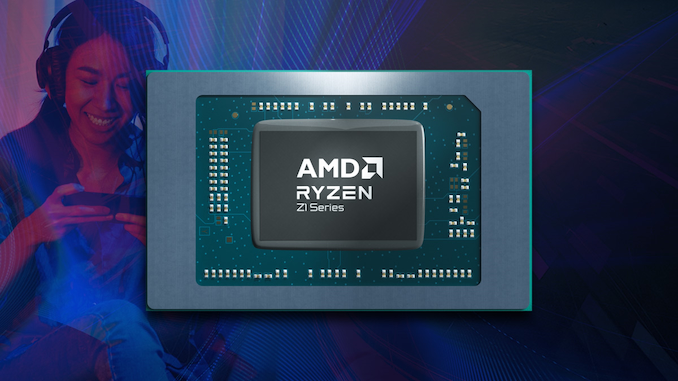AMD has announced the Ryzen Z1 series of high-performance processors for handheld PC gaming consoles. The latest Ryzen Z1 chips wield Zen 4 cores and RDNA 3 graphics, a familiar combination that AMD uses for its current mobile Ryzen 7040HS series (Phoenix) processors. And while the chipmaker hasn't officially announced any lower power Phoenix chips yet (e.g. Ryzen 7040U series), given the similarities in the feature set of the Ryzen Z1 family and the Phoenix silicon, the Ryzen Z1 series appears to be a custom-tailored Phoenix SKU that prioritizes energy efficiency for handheld gaming devices, with the lead customer being Asus and their upcoming ROG Alloy.
The Ryzen Z1 series is being introduced with two SKUs. The top-tier Ryzen Z1 Extreme has eight Zen 4 CPU cores – the maximum found on Phoenix – while the vanilla Ryzen Z1 cuts that down to six CPU cores. Meanwhile on the graphics side of matters, the Ryzen Z1 Extreme flaunts 12 RDNA 3 architecture compute units, again aligning with the max number found on Phoenix silicon. It's vanilla Z1 counterpart, on the other hand, will ship with just 4 CUs enabled, one-third as many as on the flagship part.
Both chips benefit from a 16 MB L3 cache, while the Ryzen Z1 Extreme has 2 MB more L2 cache due to its additional CPU cores. In any event, the Ryzen 1 and Ryzen Z1 Extreme possess strong computing performance thanks to the high CPU core count and the usage of AMD's latest Zen 4 cores. A hexa-core processor should suffice for handheld gaming, and either Ryzen Z1 processor will certainly outperform AMD's older custom quad-core Zen 2 SoC (Aerith) that powers Valve's Steam Deck.
| AMD Ryzen Z1 Specifications | ||||||||
| AnandTech | Cores Threads |
Base Freq |
Turbo Freq |
L2 Cache |
L3 Cache |
GPU | TDP | |
| Ryzen Z1 Extreme | 8/16 | ? | ? | 8 MB | 16 MB | 12 RDNA 3 CUs | <=30 W | |
| Ryzen Z1 | 6/12 | ? | ? | 6 MB | 16 MB | 4 RDNA 3 CUs | <=30 W | |
Hardware unit counts aisde, AMD isn't revealing the clock speeds for the two 4nm processors. Curiously, an embargoed report published by The Verge has quoted "up to" 8.6 TFLOPS and 2.6 TFLOPS graphics performance respectively, based on AMD's engineering projections. But these figures have been removed from the deck AMD has since been sending around to the rest of the press. If these figures do turn out to be reasonably close to what the final shipping silicon can hit, then that would mean we'd be looking at peak GPU clockspeeds of around 2.8GHz and 2.6GHz respectively, which is just a bit lower than what the Ryzen 7040HS chips run at.
The Ryzen Z1 series chips will support a maximum TDP of 30 Watts, which happens to be the same top power target as AMD's mobile Ryzen U-series chips. Conversely, AMD hasn't disclosed a minimum TDP, and like most mobile devices, this is likely up to the customer – in this case, Asus. For comparison, Aerith's TDP is between 4 W and 15 W, meaning the Z1 series certainly offers a good deal larger power range for customers to play with. At its top TDP, such a configuration would quickly blow through the battery in any handheld device, but for docked devices it's very feasible. As for handheld mode, it's far more likely that we'll see Z1 chips clocked very low to conserve previous power.
Being that this is an AMD product designed for PC-like devices, it has access to all AMD graphics technologies, including Radeon Chill, which helps improve battery life by adjusting frame rates based on the movements in the game. This also means that FSR will be on the table on a game-by-game basis, and RSR as a less optimal universal solution.
AMD provided some benchmarks for the Ryzen Z1 series utilizing the Asus ROG Ally. As usual, throw a pinch of salt over vendor-provided benchmarks. The device used here also had 16 GB of LPDDR5 memory and a Micron 500 MB SSD. It's important to highlight that AMD put the Asus ROG Alloy in turbo mode for its benchmarks, which means that the Ryzen Z1 series processors were operating at power levels up to 30 Watts.
AMD's results show the Ryzen Z1 Extreme delivers average frame rates above 60 FPS in most titles. However, the chipmaker tested with the lowest settings at 1080p (upscaled 720p with RSR). The Ryzen Z1's performance wasn't bad, but the two chips' delta was perceptible. The difference spans between 6% and 73%. Zen 4-based processors took a significant performance hit at native 1080p resolution on the lowest settings. As expected, the Ryzen Z1 struggled in multiple titles and didn't hit the 60 FPS mark.
Asus has first dibs on the Ryzen Z1 series; however, more competitors powered by the 4nm Ryzen Z1 chips should arrive down the road. Asus' ROG Ally will be the first handheld gaming console to feature AMD's Ryzen Z1 Extreme processor, with the company set to share more information on the handheld (including pricing) on May 11.
from AnandTech https://ift.tt/TdqUPf2
via IFTTT







0 comments:
Post a Comment